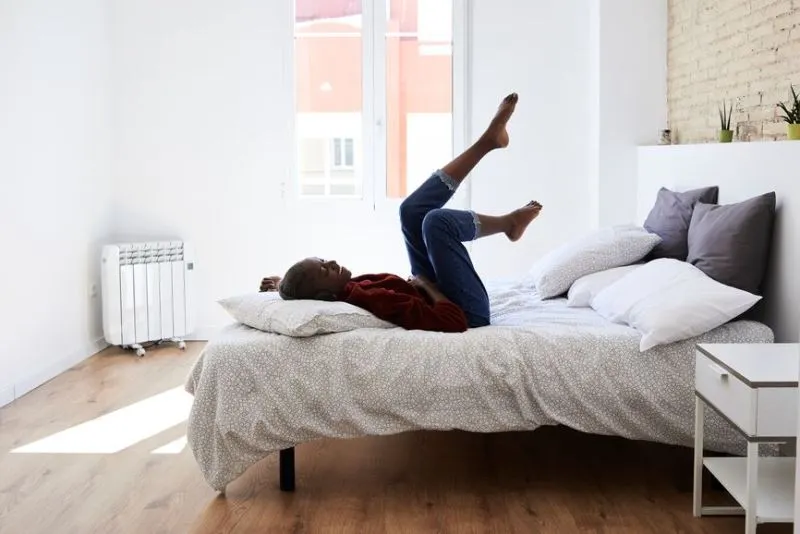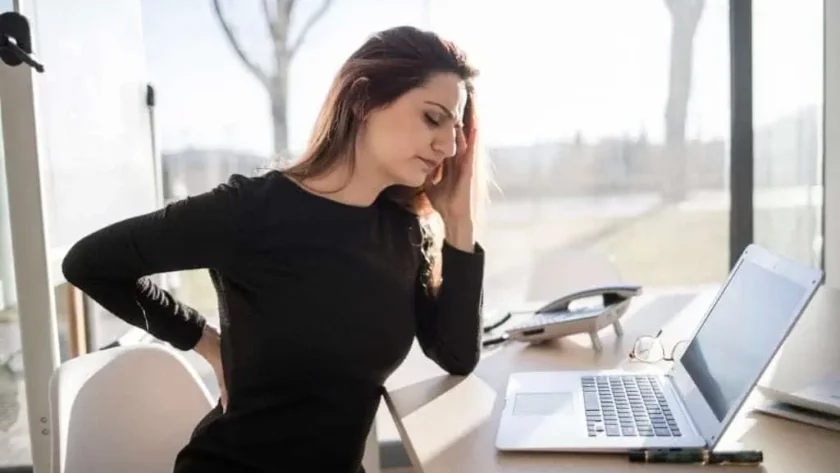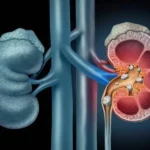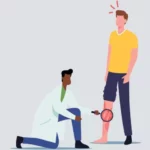What is Slip Disc?
Contents
When there is excessive pressure in the lower back, which causes cracks and breaks in the disc, which is called a slipped disc.
And when a slipped disc breaks, its sticky liquid leaks out which puts pressure on a muscle, due to which there is a lot of pain in the back.
Now Understand structure – Our spine is made up of 33 bones, known as the backbone, these bones are stacked one on top of the other and are held together by strong muscles.
One is between every two vertebrae have a disc, which contains liquid, that provides flexibility, similarly, the spinal cord is connected to the brain and muscles.
A slipped disc is also known as a herniated disc, And our all bones are connected to each other through the ligament.

2. Types
There are 3 types of slipped discs. which include:
Cervical disc slip – It happens in the neck and occurs between 5, 6, and 6,7 muscles, In this, there is a pain in the back of the head, neck, shoulder bone, arms, and hands.
Thoracic disc slip – These discs are located between the base of your neck and lower back. Its pains may occur while coughing or sneezing (1) (2).
Its symptoms include – pain, that travels around your body, tingling in areas, muscle weakness, etc. however, the chances of this happening are very less.
Lumbar disc slip – It occurs in the lower part of the spine. often occurs between the 4th and 5th vertebrae and between the triangular bone at the back of the waist.
This can be seen as a pain in the lower back. Lumbar herniated discs most often affect people aged 35 to 50.
3. Causes of Slipped disc
This happens when you put excessive pressure on the lower back.
It causes breaks in the disc, and when it breaks, its sticky liquid leaks out which affects nerves, due to which there is a pain in the back.
A disc can break due to these potential reasons include:
- Lifting heavy objects, like in the gym. it is the most common cause of breaking slipped discs or being out of place.
- Sitting, lying, lifting, and walking in poor posture
- while you are twisting or turning to lift an object
- Overweight people are more at risk of increasing their slipped disc.
- If a person has a physically demanding job that requires a lot of lifting, then they are more chances of getting slipped disc.
- Accident or any injury on backbone
- Nutrition deficiency
- Change in the shape of the spine after pregnancy delivery
- Tobacco use, which contains toxins. And toxins decrease our nutrition absorption capacity.
- People who spend more time sleeping and do not exercise, muscles become weak, which can cause slipped discs.
Other causes of back pain include:
- If you have a job for sitting for 8 hours. And if you lift more weight without any experience, then the risk of back pain is increased.
- Old person, normal aging process makes the disks more prone to herniation.
- Weak muscle and setting lifestyle may contribute in back pain
4. Symptoms
Slipped discs most occur in the lower back, which is one of the more common areas
Here are some common signs and symptoms which may be seen in a slipped disc. which include:
- Pain from waist to leg or heel and numbness may be felt
- The pain can go from the hip to the thighs.
- Weakness in muscles
- Pain also occurs during sneezing and laughing time
- Tingling feeling in the feet
- Pain may also be felt while walking
- Aching, or burning sensations in the affected area
- Pain make worse at night
Many people think that sciatica is a disease, but is one of the symptoms of slipped disc. Sciatic is a thick vein that goes through the back to the foot.
And if we have a slipped disc in the waist. then this vein is affected, causing pain that goes from the backbone to the legs.
It also has some early signs so that you can know that it is starting. and you can talk to your doctor about it. early signs such as:
- Pain or numbness in one side of the body
- Spread of pain to your hands or feet
- Pain increase night or more pain in certain activities
- Too much pain after standing or sitting
- pain when walking short distances
- unexplained muscle weakness
Patients report increased pain upon sitting, which is known to increase when the disc compression is increased to about 40% (3).
If you see these signs or any discomfort, so talk to the doctor.
5. How Common Is It?
One research estimate suggests 1 to 5% of people will have back pain caused by a slipped disc at some point in their lives.
Every year, up to 2% of people have a slipped disc. and it is more common in men than women.
People over the age of 30 are at higher risk of herniated disks.
6. How doctor Diagnose slipped disc?
First – A doctor mainly examine these things to determine what is causing it such as:
- Physcial exam – In this such as muscles strength, walking abilities, is used to determine whether you has slip disc or not.
- X-ray – It cannot diagnose its symptoms, but it can be found that some other reason is not causing back pain.
- MRI scan – It usually used to confirm a herniated disc diagnosis. It is used to locate exactly the point on the spine that affected.
- CT scan
- Myelogram – In this, a fluid is injected into the spinal cord. then x-ray is done. This test can show pressure on your back bone and nerves due to slipped disc.
A doctor may also ask about your medical history and your symptoms, like pain during walking, when did you feel the first symptoms, like these questions.
7. Treatment

Most of the time herniated discs heal on their own or with simple home-care measures.
If we talk about its treatment – slipped disc treatment depend on the grading, its grading is between 1 to 4, which the doctor detects in the MRI.
In the case of the slipped disc up to grade 3, it is treated 100% with physiotherapy and medication.
In the case of 4 grade, surgery becomes necessary and after surgery, it is treated with physiotherapy.
Surgery – In this surgery, the broken disc is removed and joint both upper and lower bone, this gives relief to the patient, but it is not permanent.
Belt – In a primary situation, a doctor gives the patient a belt to tie around the waist, which acts as a support. but it is also a temporary treatment.
Medication – The doctor may give you some medicines, like OTC, cortisone injection muscle relaxers, opioids medicines (the doctor might consider short-term use of opioids)
8. Home-remedies
There are some other home remedies which can gi
Yoga
In slipped disc, the patient is told some yoga which strengthens the muscles and ligament.
Back bending postures prove to be very effective in this, do this until your back is easily started moving back and forth.
If you start walking and sitting properly, then do some yoga asanas such as:
- Cobra asanas
- Surya namaskar
- Ardhasalabhasana
- Dhanurasana
- Vajrasana
- Ustrasana
- Matsyasana
NOTE: which you can do at home, but if you are new to yoga, then do it only under the supervision of a pro person.
Exercises
By lying straight and bending the knees, it told to press the back down, after 3 to 5 seconds left.
Bridge exercise – In this exercise involves raising the waist and then slowly lowering it.
Abdominal exercise – In this, the patient is asked to draw the stomach in and then slowly release it. keep breathing during the whole process.
Learn More – Breathing Exercises To Increase Lung Capacity – At Home
Some Other treatments include:
- Applying hot and cold bandage on the affected area also provide immediate relief.
- Massaging on that area, which also give some relief.
- Aspirin, and cooling muscles medicines also give relief, but all these is not permanent treatment.
- Too much movement or little movement, can also causes pain, so plaster can also be applied in that place.
9. How long does it take for its recovery?
Most people recover from a slipped disc within six weeks without treatment.
Acute low back pain usually has no clear cause and it goes away on its own in a few days. and if you are facing more problems then talk to the doctor.
10. Risk
If you lift a weight, until you have slipped a disc, may increase the risk of permanent nerve damage or no treatment.
In some patients, it may happen that they lose control of their urine, or bladder control.
Do repeating lifting, pulling, pushing, bending sideways, and twisting also can increase your risk of a herniated disk.
Overweight people are more at risk of this because excess weight puts extra weight on pressure on the spine, which leads to back pain or slipped disc.
NOTE: Therefore in early signs and if there is a pain in the back for a long time, talk to the doctor. this may be a sign of slipped disc.
BOTTOM LINE
Slipped disc treatment depends on the grading, its grading is between 1 to 4, which the doctor detects in the MRI.
Excessive pressure on the lower back causes breaks in the disc, and when it breaks, its sticky liquid leaks out which affects nerves, due to which there is a pain in the back.



